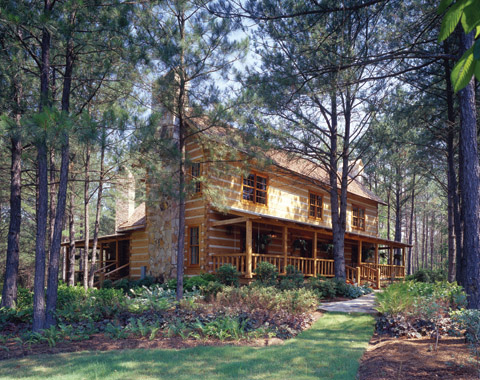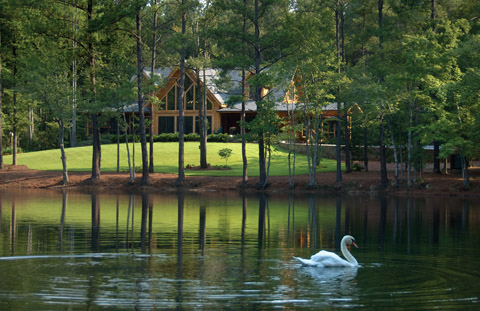Landscaping should be at the top of your list when you begin to plan your log home. A National Gardening Association survey found a well-designed and maintained landscape can increase the value of your home by as much as 15-25 percent. “Too often the landscape is an afterthought” says Maureen Parker, owner of Common Ground Landscapes in Boyne City, Michigan, “and landscape architecture is much more than plantings. Planning for your landscape starts with positioning your home on the site, selecting trees to save or remove, looking at drainage, grading and retaining concerns, and planning for circulation—driveways, walks, terraces and decks. The plants are the icing on top of the cake.”
Visualize your landscape just as you would imagine the placement and sizes of rooms within the house. Ask yourself: Do you have a growing family? If so, you might want to include a playground and space for active games. What about pets? Do you enjoy gardening? How about a patio for outside dining? Are water shortages common in your region? Consider xeriscaping, a form of landscaping that saves water by using only drought-tolerant plants.

StoneMill Log Homes
Dave Wesolowski, owner of Sprinkler King in Atascadero, California, suggests homeowners set aside at least five to seven percent of the cost of building the home for professional landscaping. In addition to adding to the value of your real estate, proper landscaping helps control sunlight, deflects wind, and keeps slopes from eroding. It creates additional living space, and it protects your privacy as it adds to the beauty of your home. Strategically placed shade trees can reduce annual fuel bills by up to 20 percent.
If you live in an area where wildfires are a threat, incorporate adequate fire breaks around the house. Rolland Kuhr, Jackson, Wyoming landscape architect, recommends a 20-30-foot green space around your home with few or no trees. Take into consideration the mature size of the trees at the time of planting. Keep your lawn green by watering it, and limit the amount of lawn. Not everyone wants to spend weekends mowing lawn or pruning shrubbery, so consider ‘No-Mow’ grass mix, a special blend of low-growing fescue turf grasses that forms a dense lawn yet requires little or no watering or fertilizing and only needs to be mowed once or twice a year. Prune tree branches up to a 10-foot level so that a ground fire is less apt to get into the crown of the tree. Never plant spruce, pine, or fir trees next to the house.
Many log home owners are leaning toward native plants because they tend to be hardier, require less water and fertilizer, and have some pest resistance. Notice what’s growing well in the wild near your house and try to repeat it. Most natives—aronias, viburnums, Joe Pye-weed, asclepias, monardas, liatris, rudbekias and agastache—are deer-proof Log homes suggest a naturalistic landscape. “A log home brings to mind wide porches, picket-fenced front yards, flagstone paths, weathered furniture, old roses, and hollyhocks,” says Edith Pederson of Pedersons’ Nursery and Landscapes in Superior, Wisconsin. “A successful landscape reflects the client’s personality and lifestyle.”

